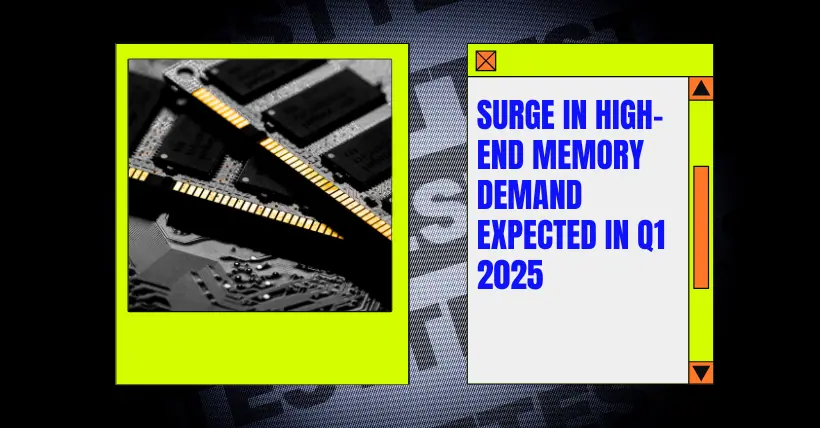Although the low-end market may remain weak in the first quarter of 2025, a recovery is expected in the second quarter.
Memory module manufacturer TeamGroup expects an increase in demand for high-end memory products in the first quarter of 2025, with low-end memory demand also expected to rise in the second quarter.
Although PC-related demand will remain sluggish in the first half of 2025, TeamGroup anticipates a recovery in the second half, driven by growing demand for AI-supported terminal devices.
TeamGroup’s revenue for Q3 2024 reached NT$6.2 billion (approximately US$191 million), a 17% quarter-over-quarter decline, but a 70% increase compared to the same period last year. Its gross margin was 7.4%, down 2.1% both quarter-over-quarter and year-over-year. The net profit after tax was NT$140 million, up 10% quarter-over-quarter and 283% year-over-year.
For the first three quarters of 2024, the company’s revenue totaled NT$16.67 billion, a 53% increase from the same period last year, with net profit after tax reaching NT$560 million.
Among TeamGroup’s four main brands, gaming memory contributed the largest revenue share, while other brands catered to niche markets like industrial memory.
The company currently maintains DRAM inventory levels of 3 to 4 months and NAND inventory of about 2 months. High-end products, including DDR5 and HBM, face supply constraints, leading to steady price increases. The low-end market, especially DDR4, sees significant price fluctuations, with demand expected to remain weak in the first quarter of 2025. However, TeamGroup predicts a recovery in the second quarter, with a potential price surge as demand rebounds later in 2025.
In the NAND market, server demand remains stable, while the mobile sector has stagnated. DDR6 is currently limited to GPU applications and will take several years to become mainstream.
Looking ahead, TeamGroup expects global demand for high-end memory to continue to rise. Although the low-end market may remain weak in Q1 2025, a recovery is anticipated in Q2. The company forecasts stronger performance in the second half of 2025, driven by growing demand for AI-related PCs and mobile devices.
Wu Yating, Senior Vice President of Research at TrendForce, also stated that in 2025, besides new production capacity from China, other mainstream DRAM suppliers will have limited capacity expansions. The reserved capacity for high-bandwidth memory (HBM) will continue to expand, and the overall production bit growth for traditional DRAM will slow down. If demand meets expectations, the price trends for advanced process products like DDR5 and LPDDR5x will remain relatively stable, while DDR4 and LPDDR4x will face more significant price pressure. In the coming year, Mobile DRAM output will be led by LPDDR5(X), reflecting strong market demand for efficient and power-saving memory solutions, which will expand beyond smartphones to PCs and AI categories.
Memory Technology Outlook for 2025 Memory technology is rapidly advancing to meet the growing demand for AI and high-performance computing. The key development trends for memory technology in 2025 are as follows:
DRAM Technology Development: In 2025, DRAM technology will focus on HBM, low-power DDR5 (LPDDR5), graphics DRAM (GDDR6), and low-latency DRAM (LLDRAM) to support AI and high-performance computing.
High-bandwidth memory processing technologies, such as Samsung’s Aquabolt-XL, are leading the market, providing more efficient data processing for AI applications. More advanced manufacturing processes, such as EUV lithography, are also driving DRAM technology progress, with Samsung and SK Hynix adopting EUV technology to improve DRAM miniaturization and performance.
By 2025, EUV lithography and improvements in high-k metal gate (HKMG) technology are expected to become major directions for DRAM development.
NAND Technology Advancements: The focus of NAND technology development is on increasing storage density and reducing production costs. QLC technology, which offers higher storage density, is gradually becoming the preferred choice for data center storage.
With the growth of AI demand, suppliers are accelerating the development of 1Tb-plus high-density NAND chips to meet the demand for high-capacity SSDs. The emergence of CXL-PNM (Compute Express Link-Processing Near Memory) technology offers new opportunities for integrated applications of NAND and DRAM, enhancing the potential of memory technology in AI and edge computing.
With the memory market’s recovery, the supply chain in 2025 will face new challenges. In particular, the increased demand for HBM could reduce the supply of traditional DRAM, requiring manufacturers to increase capacity investment to alleviate the supply-demand imbalance.
By 2025, delivery times for memory products are expected to lengthen, especially in the HBM and large-capacity SSD sectors. Supply chain management will become a crucial factor in ensuring market stability, particularly as demand for AI and edge computing continues to grow. Manufacturers will need to collaborate closely with customers to ensure smooth supply chain operations.
Memory prices in 2025 are expected to trend upward, especially in the high-performance memory sector. As AI and edge computing demand increases, prices for HBM, DDR5, and large-capacity SSDs will continue to rise. However, due to its cost-effectiveness, QLC NAND may become the preferred choice for enterprises and data centers, keeping NAND prices relatively stable.
Source: Internet
Related:
- June–July 2025 Sparks New Hike in Chip Market Prices
- Semiconductor Storage Industry Set for 24% Growth by 2025
- 3 Major Challenges in 2025 Semiconductor Industry Market
- 2025Q2 NAND Storage Price Increase: What U Need to Know

Disclaimer:
- This channel does not make any representations or warranties regarding the availability, accuracy, timeliness, effectiveness, or completeness of any information posted. It hereby disclaims any liability or consequences arising from the use of the information.
- This channel is non-commercial and non-profit. The re-posted content does not signify endorsement of its views or responsibility for its authenticity. It does not intend to constitute any other guidance. This channel is not liable for any inaccuracies or errors in the re-posted or published information, directly or indirectly.
- Some data, materials, text, images, etc., used in this channel are sourced from the internet, and all reposts are duly credited to their sources. If you discover any work that infringes on your intellectual property rights or personal legal interests, please contact us, and we will promptly modify or remove it.



